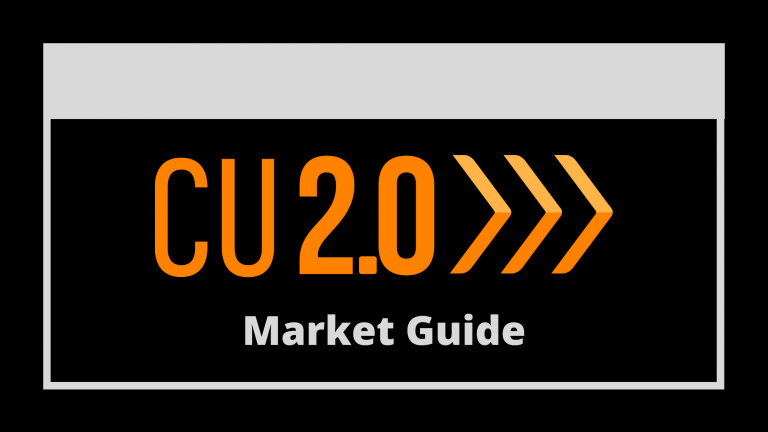Banking habits are changing. Consequently, the way banking services are provided must change.
This Checking 2.0 Guide will give you context and insight about market trends, consumer behavior, and peer benchmarks. By the end of the guide, you should have a better understanding of the direction that checking accounts might take (or are already taking)—and you’ll learn about new fintechs that can help you modernize your offering.
This is a limited version of the guide—download the full version here!
After COVID-19 hit the U.S., digital transformation and digital-first strategies boomed—an acceleration of an already prominent trend. 2021 should truly reposition most credit unions’ top service delivery from branches to digital. All signs indicate that we will never go back to non-digital channels being the primary way members interact with us.
Incidentally, this opens opportunities for new competitors. Many years ago, the introductions of Apple Pay and Google Pay concerned many credit unions. Today, those products have each taken vastly different directions and are carving out different strengths. Apple has pursued credit card dominance, and Google is planning to disrupt checking accounts. Amazon will pile on too. Oh, and don’t get me started on the phone companies.
At the same time, overdraft lawsuits abound. One of the primary income drivers for credit union checking accounts appears to be challenged. Debit card usage continues to displace checks. All of this raises the question: Is it time to radically reimagine the checking account?
Should your credit union look at offering a subscription product that helps you capture Gen Z, Millennials, and—dare I say—digital-only members?
If you share that question, this guide is for you. Credit Union 2.0 has looked at the checking of the future, a.k.a. Checking 2.0. We’ve evaluated several key fintechs and technologies that may inspire your credit union to reinvent itself… before your competition does it for you!
Overview of the Credit Union 2.0 Checking Guide
- Market assessment and key trends
- Impact on credit unions
- Credit union benchmark / self-assessment of Checking 2.0 programs
- How to evaluate fintech share draft solutions within the checking account space
- Fintech integration model
- Checking fintech list and rankings
- Time frame and predictions of market direction
- Key conclusions
Market Assessment and Key Trends
1. Age is no longer a differentiator for retail banking preferences. WHOA.
This is a huge shift in thinking about how consumers bank. Digital adoption accelerated during the pandemic. It won’t go back. Once someone tries remote deposit capture, they aren’t taking a trip to the branch to do the same thing, but slower. COVID-19 forced consumers to try all sorts of things that were already easier, more convenient, and better! If the older generations can see their doctors via Zoom, they can bank using an iPad.
As you can see by the graph, younger generations aren’t even the most prolific digital banking segment in the market. When it comes to everyday transactions, Millennials and Gen Z are the least likely to go digital—those aged 65 and older show they’re more than comfortable with routine remote banking.

2. Debit and mobile will continue to lead the shift. DUH.
If you missed this trend, I am not sure what to tell you. Checks are out, debit cards are in. Everyone has phones now. Get out from under your rock and re-think the modern checking account.
We’d love to elaborate on this, but there’s no point.


3. Over 80% of financial institutions allow you to open an account online, and 38% can do it over a phone.
In 2020, a CU 2.0 secret shopper attempted to open accounts at credit unions in the Pacific Northwest. The shopper was told to enter the branch to complete their enrollment. This was all while western states were experiencing various levels of lockdowns due to the COVID-19 pandemic. It was more than inconvenient—it was unsafe.
The shopper’s experience stood in stark contrast to some of CU 2.0’s favorite fintechs, such as Robinhood and Acorns. The team asked, “If I can open an account, get a debit card mailed to me, begin investing, and receive financial education within 30 minutes… why would we make the effort to join a credit union?”
The fact is that most financial institutions are making it easy to join and bank with them. Credit unions who don’t support online account opening are losing out on members who value their own time.

#4. Members care about security
A recent study by PaymentVision showed that the #1 consumer concern is security/privacy. Breach Clarity also debuted a report that mentioned the same thing. The graph from MX completes the chorus.
To be fair, security and privacy aren’t usually selling points. Rather, they undergird every other selling point. But the point is that most consumers are sensitive to security issues, and if they don’t trust a platform, they won’t use it—no matter its features.

4. Consumers don’t care about using a bank or credit union for their checking account.
Credit unions have long prided themselves on their member experience. However, as banking continues to move to the digital arena—especially during the pandemic—the member experience is increasingly digital. Whoever provides the best digital banking experience will ultimately capture the most market share.
People will flock to whichever provider offers a good experience, rates, terms, etc. More and more often, that means banks, fintechs, and even giant tech companies. Yes, people appreciate the credit union non-profit model and emphasis on community impact, but don’t expect that to sustain you indefinitely.
Additionally, research from Novantas suggests that consumers are more than willing to bank with tech providers like Amazon, Facebook, Apple, and Google. After the pandemic accelerated branchless banking, that trend should factor into your long-term strategy.
5. Traditional Fee Income derived from checking accounts is in jeopardy
Whether it be from regulations, check decline, COVID-19, or new entrants to the market… Non-interest fee income has a problem. Fee income is hard to determine (as you can see in the Callahan’s study). It varies greatly by credit union. But traditional overdraft fee income is generally a big part of most credit unions and has been under attack from COVID-19 and changes in consumer behavior.
Additionally, as the new administration sets its priorities, we may see additional changes to overdraft regulations and guidance. Credit unions may not want to rely on fee income the way they used to, or they may face a difficult transition period in the coming months or years.

Also see the Callahan & Associates study:

6. Overdraft Class Action Litigation Trend Continues
On top of all of that, class actions on overdraft issues continues and will continue until credit unions connect the digital dots between consumer choice and processing choice. If you’re a credit union or bank executive, chances are that you’ve lost multiple days of your life trying to determine if it’s better to process large items first and clear the small items or vice versa. These are problems that frankly shouldn’t be applied universally as they are a consumer choice, and they impact everyone differently.
Until the consumer makes their own choice, the lawsuits and legal assaults will continue. Ultimately, we aren’t bullish on the future of overdraft fees.
Credit Union Impact
Want to learn more? Access the full guide here!
The first thing a credit union needs to ask is: Where are we on the “S” curve of traditional checking accounts?
- Vanilla checking with tweaks correlating to membership life stages?
- Specific products targeting multiple demographics?
- Upsized checking with other services to attract and retain ideal members?
In our experience, credit unions are all over the place.
To help you find where your checking account sits in relation to competitors, we created a self-assessment model. Simply answer the questions below the chart and estimate where you sit on the graph.
Do you provide a default checking account with few perks or conveniences? Yikes.
Do you support online banking and some competitive features? You’ll stay viable for a while.
Can members open an account online? Do you have popular features or integrations? You’re ahead of the curve!
Do you support P2P payments, rewards, interest, etc.? Then you’re leading among credit unions—and providing healthy competition for fintechs and other tech-heavy competitors!
Checking Account Market Assessment Model

Not sure where you stand on this model? Looking for a way to go from a “5” to an “8”? CU 2.0 provides technology consulting and coaching!
Visit our website at www.cu-2.com or inquire at info@localhost to learn more.
Self-Assessment Scoring Questions
- Do you have a loyalty or patronage rewards program that puts the member first?
- Do you bundle other key services into the checking account?
- Does your overdraft protection give the member choice?
- Have you optimized all aspects of online, mobile, P2P services and do you test them regularly?
- Have you optimized the first 100 days and reduced unnecessary attrition?
- Are your products mapped to the members life stage, personas, journey, or demographics?
- Do you offer online banking? How about online account opening?
- Do you provide or integrate popular tools for budgeting, saving, investing, etc.?
How to evaluate fintech Share Draft solutions For Checking Accounts

While there are many ways to evaluate checking solutions, we feel the best way is a guided review process using this model. Here’s how to read the model:
- At the center is the primary goal: Checking 2.0.
- The light blue intersections show secondary goals.
- The dark blue circles are the key categories that support both primary and secondary goals.
- Around each category are three accelerators that drive adoption, engagement, and enthusiasm among your membership.
Each accelerator must be in place. Each category must be fleshed out. Without them, Checking 2.0 isn’t possible. First, we explore each category and what it means. On the table for each category, we provide space for you to self-evaluate your performance on a 1–10 scale. A score of 1 means you have nothing like it, and a score of 10 means you feel confident that your solution is industry leading.
- Subscription Checking
This is a concept based on the modern economy which seeks to create enough value for a consumer that they pay a monthly fee. Netflix, Amazon Prime, Hulu, Spotify etc. are all examples of subscription economic approaches. With Amazon Prime, Amazon has bundled in free shipping, music, various B movies and made for Amazon entertainment.
Many credit unions have talked about creating a checking account that bundles various services to add more value. Three key levers include:
| Subscription Accelerator | Example | Rating for Your Checking Account |
| Music Streaming Services | Kasasa Tunes includes credits back on iTunes, Amazon Music, or Google Play. | |
| Coupon / Shopping Tools | Google Pay has embedded discount options into its new checking account. | |
| Local Incentives | Rogue Credit Union has deals like 3% discounts at local grocery stores or 10% off the local Food Co-op. | |
| Security Monitoring | Identify theft monitoring is a key way to help consumers protect their identity and demonstrate unique security attributes. | |
| Credit Scoring | Free credit scoring and monitoring helps ensure that members stay in good standing. |
How do your scores look for subscription checking accelerators? Which areas look like they need work?
- Payments Optimized
This section focuses on the payment aspects of transacting business. The reality is that consumers will always seek out unique, regional, local, and other forms of payments. These can be highly customized to your local market and included checks, debit cards, peer to peer payment options, and support of Google, Samsung, or Apple Pay, as well as other options.
To compete in this category, it’s key to make payments and accelerators as frictionless as possible to compete with national bank brands and technology companies.
| Payments Accelerator | Example | Rating for Your Checking Account |
| P2P Optimized | Make it easy for your members to use Paypal, Venmo, Zelle®, Cash Access, and any other major Peer to Peer payment solution. Don’t believe that you can control what your members can use—any attempt will just slowly erode trust and acceptance of your account. | |
| Debit Driven | Provide incentives, rewards, and tools that enhance the average debit experience. These can include things like Keep the Change programs, cash back rewards, free access to thousands of ATMs, etc. | |
| Bill Pay 2.0 | Traditional Bill Pay continues to have some appeal but is slowly dying off for more electronic/less check driven methods. Solutions like Positive Pay (OCR bill pay scanning) or AI-/machine learning-driven solutions would be big enhancements and differentiate the financial institution. |
How do your scores look for payments accelerators? Which areas look like they need work?
3. Digital First
We can all agree that COVID-19 has shifted consumer behavior. Now that more than 80% of all consumers prefer some form of digital services, streamlining the digital experience is key. This includes online account opening, mobile driven, and overdraft enhanced.
| Digital First | Example | Rating for Your Checking Account |
| Online Account Opening | If the consumer can’t enroll and setup their new account in under 5 minutes from the comfort of their couch, you have a big problem. | |
| Digitally Optimized | This includes the strength of your mobile solution, ability to tailor and craft the user experience, adoption of solutions through data-driven marketing automation, and analytics-driven understanding of consumer behavior. Don’t make the same offer 18 times in every channel… | |
| Optimized Overdraft | Overdraft that is bank-driven instead of consumer-driven will have compliance issues, provide poor service, and be a detractor. Instead, find a way to provide the consumer a choice on which items to pay, alternative funding options, and other solutions that empower them to make the best choice for them. | |
| Digital Identity | Providing consumers with a sovereign identity model that integrates seamlessly other providers (while protecting their privacy) is key for transformation. Everything starts with the identity—and we’re not talking single sign-on! |
How do your scores look for digital-first accelerators? Which areas look like they need work?
Checking Fintech List and Rankings
For many of you, this list is the main reason you’re reading our Checking 2.0 Guide. Each listed fintech has different strengths and weaknesses. Several are geared more toward individual categories or accelerators. This means that while some are competitors, many provide complementary services.
If you’re looking to supercharge your checking product, all these fintechs could provide you the edge you need to bring your self-assessment scores, delight your account holders, and push you toward a true Checking 2.0 product.
Our Ratings column lists which category each fintech affects. We’ve assigned numerical values to the potential impact a fintech might have on relevant categories:
- +1 = Slight improvement
- +2 = Moderate improvement
- +3 = Significant improvement
None of the fintechs below will take you from a 1 to a 10 on your self-assessment. Yet a couple of fintechs together may take you from a basic, default offering to an industry-leading one.
Please download the guide to see our fintech rankings!
Time Frame and Predictions of Market Direction

Strategy and alignment are necessary for any good decision. Determining how quickly you need to get on the Checking 2.0 bandwagon is critical. Maybe your competition is already barreling towards digital growth and transformation. Maybe you have a captive audience and can afford to take more time.
Either way, the checking account subscription, digital, and payment experience in the next decade will look very different. Consumer expectations will shift, and the demand for basic checking will plummet. The sooner you start making progress, the sooner you avoid becoming “Mom’s checking.”
The first step to modernization is seeing where you can improve. The second step is in finding solutions that can take you from basic checking to Checking 2.0—the standard account experience of the very near future.
Key Conclusions
2020 to 2030 will be a decade of banking modernization. There is simply too much capital, entrepreneurial spirit, and innovation going into the space. Credit unions needs to quickly define their strategy, begin implementing changes, and get ready for a much higher level of competition where consumers will expect a lot more from their money!
Want to stay in the loop? CU 2.0 offers free quarterly consulting calls to credit union leaders. In 30 minutes, we’ll introduce you to new technologies, vendors, and products that can modernize your operations, product suite, and member experience.
Visit our website at www.cu-2.com or inquire at info@localhost to learn more.
Download the full subscription Checking / Share Draft 2.0 Guide here!




